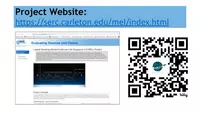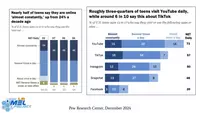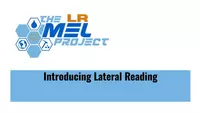2025 Georgia Institute:
Teaching Students to Evaluate Sources and Claims

×
Day 1
Logistics
Icebreaker & Introductions
- Icebreaker (Acrobat (PDF) 1MB Jun2 25)
Science in the News
How often do you see claims made in the news that seem to be backed by scientific evidence? How can you tell what is real and what is not? Analyze two sources to identify claims or models and the evidence that supports them.
- Activity 2: Science in the News (Acrobat (PDF) 849kB Jun2 25)
- Activity 2A Handout: What Can We Learn From These Sources (Acrobat (PDF) 84kB Jun2 25)
- Source#1: Measles Truth or Consequences
- Source #2: Global measles cases almost double in a year, say researchers
- Hurricane Helene Was Engineered (Acrobat (PDF) 136kB Jun2 25)
- Activity 2B Handout: What can we learn from these sources? (Acrobat (PDF) 45kB Jun4 23)
- Source#1: What to Know About the Study Linking a Popular Artificial Sweetener to Cardiovascular Disease
- Source #2: Debunking The Erythritol Study
Break
Break
- ....a little time for yourself
Disciplinary Venn Diagram
Consider how Science, Social Studies, and Language Arts practices overlap in each content area.
- Activity 3: Disciplinary Venn Diagram (Acrobat (PDF) 2MB Jun2 25)
- Disciplinary Venn Diagram (Acrobat (PDF) 77kB Jun5 23)
Website Introduction
Slides and Handouts from the workshop and other resources
- Activity 4: Project Website (Acrobat (PDF) 538kB Jun2 25)
Lunch
Lunch!

×
LR Activity: Conserving Attention with Lateral Reading
While students are able to quickly access vast amounts of information today, they often need help deciding what deserves their attention.
- Activity 5: Conserving Attention with Lateral Reading (Acrobat (PDF) 2.6MB Jun2 25)
LR Activity: Introduction to Credibility
What does it mean for a source to be credible? How do you decide whether to believe someone?
- Activity 6: Intro to Credibility (Acrobat (PDF) 1.1MB Jun2 25)
- Intro to Credibility Guiding Questions (Acrobat (PDF) 143kB Jun2 25)
Break
Break
- ....a little time for yourself
MEL Activity: Wetlands pcMEL
Use a pre-constructed MEL (pcMEL) diagram to investigate two explanations about how wetlands affect humans and the environment.
- Activity 7: Wetlands pcMEL (Acrobat (PDF) 2.5MB Jun3 25)
- Wetlands pcMEL Teaching Resources
Connections between LR and MEL Activities
Revisit your Disciplinary Venn Diagram posters. What connections exist between an LR lesson and a MEL lesson? What further connections can we make?
- Activity 8: Connections (Acrobat (PDF) 382kB Jun20 25)
Wrap Up
Feedback on two questions: 1) How do you feel after today? and 2) What questions do you have after today?
- 1) How do you feel after today?
- 2) What questions do you have after today?
[fullimage XXXXX left]
Day 2
LR Activity: Introducing Lateral Reading
What does it mean for a source to be credible? Why should we investigate whether a source is credible before we read it?
- Activity 10: Introducing Lateral Reading (Acrobat (PDF) 979kB Jun20 25)
- Lateral Reading Guiding Questions (Acrobat (PDF) 83kB Jun20 25)
MEL Activity: Soil and Food Security baMEL
Soil and Food Security baMELMEL Activity: Energy baMEL
- Activity 14: Energy baMEL (Acrobat (PDF) 1.6MB Jun3 25)
- Alternative Fuels Data Center
- U.S. Energy Information Administration
MEL Activity: Assessment
Assessing and applying students' understanding of the scientific practices and crosscutting conceptsMEL Activity: Dead Zones baMEL
A dead zone is an area of water that is low in oxygen. Aquatic life cannot survive in a dead zone. Build a MEL (baMEL) diagram to investigate whether and how aquatic dead zones may be repaired. Choose from three models and eight lines of evidence.
- MEL Activity: Dead Zones baMEL (Acrobat (PDF) 1.9MB Jul25 24)
- Dead Zones baMEL Teaching Resources Below
- Plausibility Ranking Task (Acrobat (PDF) 76kB May6 24)
- Dead Zones baMEL Model Plausibility Ratings (Acrobat (PDF) 146kB Jul10 25)
- Dead Zones baMEL Model Cards (Acrobat (PDF) 57kB Jun30 24)
- Dead Zones baMEL Large Model Cards (Acrobat (PDF) 130kB Jun30 24)
- Dead Zones baMEL Evidence Cards (Acrobat (PDF) 30kB Jun30 24)
- Dead Zones baMEL Large Evidence Cards (Acrobat (PDF) 41kB Aug1 23)
- Dead Zones baMEL - Evidence Texts Color (Acrobat (PDF) 2MB Jun30 24)
- baMEL Diagram (Acrobat (PDF) 183kB Jun26 25)
- Explanation Task (Acrobat (PDF) 52kB May6 24)
LR & MEL Teacher Guides
Exploring Socioscientific Issues Through Evidence-Based Argumentation with MEL Diagrams- MEL Project Teacher Guide
- MEL Explanation Task Rubric Teacher Guide (Acrobat (PDF) 70kB Jun4 25)
MEL & LR Implementation Planning & Evaluation
- Activity 26: Implementation Planning & Evaluation (Acrobat (PDF) 543kB Jun5 25)
- Template

![[creative commons]](/images/creativecommons_16.png)














